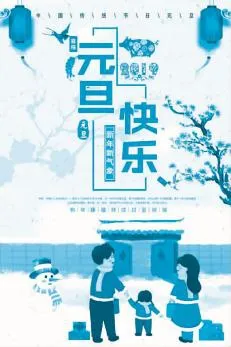❷The origin of New Year's Day
江西 戴剑国(编)
◆语篇导读
“元旦”一词始于“三皇五帝”时期,据唐代房玄龄等人写的《晋书》上记载,正月称为“元”,初一为“旦”。我们从小就知道,每年阳历(公历)1月1日就是“元旦”,但是又有多少人知道它的具体来历呢?

In ancient China,Yuan Dan was not on January 1st,asregulatedinthe Gregorian calendar.The date of Yuan Dan had been changed many times from the 1st of the 12th lunar month in Yin Dynasty to the 1st of the 1st lunar month in Han Dynasty.When Sun Yat-sentook officeas thetemporaryPresident in Nanjing at the beginning of January of 1912,he set the 1st of the 1st lunar month as the Spring Festival while the 1st of January was set as the New Year,which was also called Yuan Dan.
In 1949,the Central Government of Chinaissueda National Festival andMemorialDay and set January 1st as Yuan Dan,which was a oneday holiday for the whole country.In order todistinguishthe two New Years of both the lunar calendar and solar calendar,and as the“Spring Beginning”of the lunar calendar was always around the lunar New Year,the 1st of the 1st lunar month was called the Spring Festival.
Yuan means the beginning,the first.The beginning of a number is Yuan.Dan,which is apictographic characterin the Chinese language,means the sun rises from the horizon,symbolizingthe beginning of a day.When Yuan and Dan are combined,it means the first day of a New Year.Yuan Dan is also called Three Yuan,the beginning of a year,the beginning of a month and the beginning of an hour.The word Yuan Dan was first used duringtheThreeSovereigns and Five Emperorsera.
◆词语积淀
regulate/΄regjuleɪt/v.调节;控制
the Gregorian calendar公历
take office就职
temporary/΄temprəri/adj.临时的;暂时的
issue/΄ɪ∫uː/v.宣布;公布;发出
memorial/mə΄mɔːriəl/adj.纪念的;悼念的
distinguish/dɪ΄stɪŋgwɪ∫/v.区分;辨别
pictographic character象形字
symbolize/΄sɪmbəlaɪz/v.象征;是……的象征;代表
era/΄ɪərə/n.年代;时代
◆典句赏析
1.The date of Yuan Dan had been changed many times from the 1st of the 12th lunar month in Yin Dynasty to the 1st of the 1st lunar month in Han Dynasty.元旦的日期从殷代腊月初一到汉代的正月初一已经改了很多次。
句中的had been changed为过去完成时的被动语态形式,表示在过去某一时刻或动作以前已被完成了的动作;过去完成时也可以表示从过去的某一时间开始,一直延续到过去另一时间的动作或状态。
【即时尝试】当公共汽车来的时候,我在车站已经等了20分钟。
2.In order to distinguish the two New Years of both the lunar calendar and solar calendar,and as the“Spring Beginning”of the lunar calendar was always around the lunar New Year,the 1st of the 1st lunar month was called the Spring Festival.为了区分农历和公历的两个新年,鉴于农历中的“立春”恰好在农历新年的前后,便把农历正月初一称为“春节”。
介词短语in order to意为“为了……;以便……”,后面直接接动词原形,在句子中作目的状语。
【即时尝试】为了能通过考试,我们应该努力学习。
3.Dan,which is a pictographic character in the Chinese language,means the sun rises from the horizon,symbolizing the beginning of a day.“旦”在中国文字里是象形字,表示太阳从地平线上升起,象征着一天的开始。
这是一个复合句,which is a pictographic character in the Chinese language是由关系代词which引导的非限制性定语从句;symbolizing the beginning of a day为现在分词短语,在句中作伴随状语。其中the beginning of是固定词组,意为“……的开始;……的开头”,后面可接名词或代词。
【即时尝试】这些苹果树是我三年前栽的,还没有结过果实。
译文助读
在古代中国,按公历来说,元旦并不是1月1日这一天。元旦的日期从殷代腊月初一到汉代的正月初一已经改了很多次。1912年1月初,孙中山在南京就任中华民国临时大总统时,决定把农历的正月初一叫作“春节”,把公历的1月1日改为“新年”,也叫作“元旦”。
1949年,中华人民共和国中央政府公布了全国假日和纪念日,并确定1月1日为元旦,全国放假一天。为了区分农历和公历的两个新年,鉴于农历中的“立春”总是在农历新年的前后,便把农历正月初一称为“春节”。
“元”意为“开始;第一”,数字的第一个称“元”。“旦”在中国文字里是象形文字,表示太阳从地平线上升起,象征着一天的开始。当“元”和“旦”相结合时,就表示一年开始的第一天。元旦又称为“三元”,即岁之元、月之元和时之元。元旦最早可以追溯到“三皇五帝”时期。


